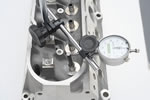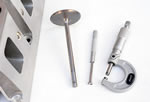Ruthless Pursuit of Power: The Mystique of the C6 Corvette LS7 Engine - Page 22 of 26
Ruthless Pursuit of Power: Lucky Seven Edition: The Mystique of the 7-Liter, 7000-RPM, LS7 - Page 22 of 26
 |
 |
by Hib Halverson
© May 2013— Updated: February 2016
No use without permission, All Rights Reserved
Be Proactive. Get Tested
If you have an LS7 making more valve noise than you think is normal and its oil consumption has gone up, the valve guides are likely worn. if you keep driving the engine; you risk catastrophic failure. Our advice: if your LS7 exhibits those characteristics, take immediate action.
If your engine is still under warranty, take your Z06 to your Chevrolet dealer and have them assess the problem. If your engine is making too much valve noise or has excessive oil consumption, they will remove your heads and measure the valve-stem-to-guide clearances. The GM-specified "service maximum" valve stem clearance is 0.0037-in. If you have clearances greater than that, your heads should get replaced under warranty.
How do GM dealers measure stem-to-guide clearance? Starting in the late-1960s, a "Wiggle Test" was how they supported a warranty claim for valve guide wear. This test required the dealer to pull the heads, disassemble them, then "wiggle" the valves in the guides and measure their movement with a dial indicator. The Wiggle Test has been discredited by both the CAC Technical Staff and GM Powertrain due to poor accuracy.
As of March 2015, GM no longer condones Wiggle Testing. Currently, if a GM dealer wants to measure stem-to-guide clearances on engine under warranty, they must use the testing procedure discussed in GM's Electronic Service Information ("ESI") to which all dealers have access. A brief summary of the procedure is: remove and disassemble the heads. Gauge the valve guide inside diameters with a hole gauge, then measure the gauge with a micrometer. Next, measure the valve stem outside diameters with a micrometer. Finally, to get the clearance, subtract the valve stem OD from the guide ID.
DIYs wanting to test their heads should use one of four, test procedures. The first three are for heads off-engine and the fourth is for heads on-engine and all are capable of greater accuracy than the old Wiggle Test.
They are: 1) (reasonably accurate) the GM dealer method discussed above or, 2) (more accurate) directly measure the guide's inside diameter with a dial bore gage and the valve stem diameter with a micrometer then subtract the second measurement from the first for the clearance or 3) (most accurate field method) use a Sunnen P-310, a specialized measuring tool used in cylinder head service work, to directly measure the clearance. Well, ok–there is a another way: a half-a-million dollar coordinate measuring machine (CMM) which is accurate to two millionths of an inch, but few DIYs will ever see one–much less get to use it to measure LS7 valve guide clearance.
To assess valve guide wear with the heads on the engine, use the Corvette Action Center's "Heads-on-Test", a modified/improved version of the Wiggle Test Service Manuals specified for measuring valve guide wear in the field until 2015. It's mainly a procedure done in a case of an out-of-warranty head where guide wear is likely but not documented and the car owner wants to avoid the cost of head removal and disassembly for measurement. Briefly, an "HO" Test goes like this: remove the valve gear for #1 intake valve and set up a specialized measuring tool, called a "test indicator", to check valve stem clearance. With the indicator's measuring point touching the valve stem right above the top of the guide and 90° to the length of the head, move the valve stem towards and away from the rocker arm mount while reading the indicator. Do the same test with the other seven valves on that bank. The GM-specified maximum for stem-to-guide clearance is 0.0037-in. If all eight in the first head pass the test, the chances are good the rest are ok, too. On the other hand, if you have bad guides on the first head, it's likely you have them on the second head so pull both and have them repaired.
While the Heads-on-Test is more accurate than the now-discredited Wiggle Test, it still lacks accuracy enough to be acceptable for making a claim on a factory warranty. If you believe your guides are worn and figure on using the HO Test as ammo to get heads replaced, it's not gonna happen. The dealer will still require the heads be removed and guide wear measured per GM Service Information. For a deeper discussion of the CAC's "Head's On Test, read this sidebar article.
Guide Wear Hits Close to Home
Unfortunately for us and contrary to GM's statements about heads being 100% inspected after February 2011, LS7 heads manufactured after that point may have worn guides yet not exhibit excessive valve noise nor have problems with high oil use. Proof of that is the Corvette Action Center's 2012 Z06 long-term test vehicle, the engine in which was assembled in February 2012.
Our discovery started out innocently enough. As a way to better understand Wiggle Testing and to enable us to photograph the process, in the Spring of 2014, we measured the clearance on all valves in the car's engine. At the time, the Wiggle Test was still the GM-mandated way to measure stem-to-guide clearance.
This engine had no trouble with exhaust valves or exhaust valve guides. All of the exhaust guide clearances were nominal, measuring inside the production tolerance of .001-.0026-in. with the worst exhaust guide having .0025-in. clearance on its thrust vector. That said, we were find seven of the eight intake guides were worn outside the production tolerance and two worn greater than the service maximum of .0037-in.
This LS7 was assembled about a year after the date at which GM stated it had solved the guide wear problem. The engine had 16,334 miles on it at the time of the measuring. All of the miles were street driving with the majority highway use and small amount of the miles were aggressive street driving typical of the type for which the LS7 was designed. The oil used was Mobil 1 5W30 for the first thousand miles and then Red Line 10W30 after that. Oil consumption for the entire 16,334 miles was 1.5 quarts. The engine was not making any abnormal valve noise and its MIL was not on. There were no modifications to the short block, the cylinder heads, the valvetrain or the induction system.
 |
 |



